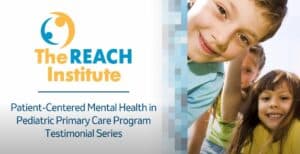10 ways to help families through the holidays
- November 17, 2020
- The REACH Institute
- Child mental health Parents,

If you’re like most pediatric primary care providers (PCPs), you’ve seen an increase in child mental health issues due to COVID. Research shows that the pandemic, with its consequent disruption and isolation, has increased adolescents’ risk of trauma, depression, and anxiety.
Families are dealing with grief, the anxiety of whatever “school” means this week or this month, and, in many cases, loss of income. Families of color and low-income families have been hardest hit by the pandemic itself, by the economic and social fallout, and by the attendant impairment of mental health.
And now come the holidays.
Much of what people love about Thanksgiving, Hanukkah, Christmas, Kwanzaa, New Year’s, and other celebrations involves activities we know to be unsafe: traveling, gathering, singing, sharing meals.
Many families will choose to follow CDC guidelines by celebrating within their household. Many children — and adults, for that matter — will experience the effects of safe choices as yet another loss in a year full of losses.
What can PCPs do to help children and families whose pandemic-related struggles get harder during what is supposed to be a celebratory time? Here are our research-based suggestions.
- Put on your own oxygen mask.
Remember that you, too, are stressed and grieving. Take time to breathe, rest, have fun, go outdoors. You, your loved ones, your colleagues, and your patients will all be better for it. - Help families take the long view.
“Remind families that staying safe now will help them ensure that they will have future holidays with loved ones,” said Ruth Stein, MD, REACH faculty member. - Redouble your awareness.
No doubt you’ve been alert to patients’ mental health since the pandemic began. The holidays give you an opportunity to ask again how a patient is doing. Patients whose mood has deteriorated the longer they have been deprived of normal socialization may not be aware of the change until you ask. - Ask open-ended questions.
A conversation starter might be something like “How do you feel about Thanksgiving coming up?” Listen between the lines. Ask follow-up questions to hear what’s really going on with this patient or caregiver. - Normalize the pain.
Almost everyone is feeling some degree of grief over the loss of holiday traditions. Tell patients and caregivers explicitly that their suffering is a normal reaction to an abnormal situation. - Use your screening tools.
The tools you received in your REACH training to screen for depression, anxiety, and other disorders can show you whether a fuller assessment is in order. They can also spark conversation about challenges and coping strategies. - Empower the caregivers.
Family support is a strong predictor of child resilience. Listen to caregivers’ concerns about the upcoming holidays. Educate them about how to deal with their child’s mental health challenges, and help them identify coping tools. Encourage them to be creative about holiday traditions. (See Resources.) For example, said Dr. Stein, “sharing holiday meals remotely on Facetime or Zoom may help them feel more like a celebration.” - Emphasize the importance of routine.
Children, including teens, need structure. Keeping normal bedtimes and mealtimes — standard advice for reducing stress during any holiday season — is more important this year than ever. Encourage families to keep the holiday rituals they can do safely, such as lighting the menorah or decorating the Christmas tree at home. - Discuss medication if indicated.
“During COVID I have found that many children and young adults who were managing well with therapy now have become overwhelmed by their emotions to the point they need medication,” said Deborah Buccino, MD, REACH board member. The many losses associated with COVID — loss of normal school or college, of extracurriculars, of the fun things patients normally get to do — add up. “They’re left with a lot of schoolwork on their hands,” noted Dr. Buccino. “Also, isolation means patients spend more time ‘in their head’ with negative thoughts. Plus, they don’t have the friendship connections that research shows can protect people from anxiety and depression.” In these cases, medication may be useful in the short term — six to 12 months as opposed to years — to help patients regain their capacity to use the supports and skills they have in their toolkit so they can get through this tough time. - Watch for seasonal depression.
Seasonal affective disorder (SAD), categorized in DSM-5 as “major depressive disorder with seasonal pattern,” commonly begins in young adulthood, but it can affect adolescents. Diagnosis of SAD requires at least two instances of depression that begins in fall or winter and remits in spring. Light therapy is the gold-standard treatment; cognitive behavioral therapy and medication can also be effective. (See Resources.)
RESOURCES
For you
- Interim Guidance on Supporting the Emotional and Behavioral Health Needs of Children, Adolescents, and Families During the COVID-19 Pandemic from the American Academy of Pediatrics
- Guessoum SB, Lachal J, Radjack R, et al. Adolescent psychiatric disorders during the COVID-19 pandemic and lockdown. Psychiatry Res. 2020;291:113264. doi:10.1016/j.psychres.2020.113264
- Kurlansik SL, & Ibay, AD. Seasonal affective disorder. Am Fam Physician. 2012 Dec 1;86(11):1037-1041.
For parents
- CDC guidelines on Holiday Celebrations
- Mental Health and the Holiday Blues from the National Alliance on Mental Illness
- Helping Kids Cope with the Holidays During the Pandemic (PDF) from the American Academy of Child and Adolescent Psychiatry
Categories
- ADHD
- Anti-racism
- Anxiety
- Assessment & screening
- Autism
- Child mental health
- Coding
- Cognitive behavioral therapy
- College transition
- Culturally responsive
- Depression
- Eating disorders
- Foster care
- Grief
- High-risk children & youth
- LGBTQIA
- Medication
- Parents
- Patient communication
- Pediatric primary care
- School refusal
- Sleep disorders
- Suicide
- Trauma
- Show All Categories
Dates
Register for courses
“The REACH Insitute Video Testimonial: Priya  ”
”
